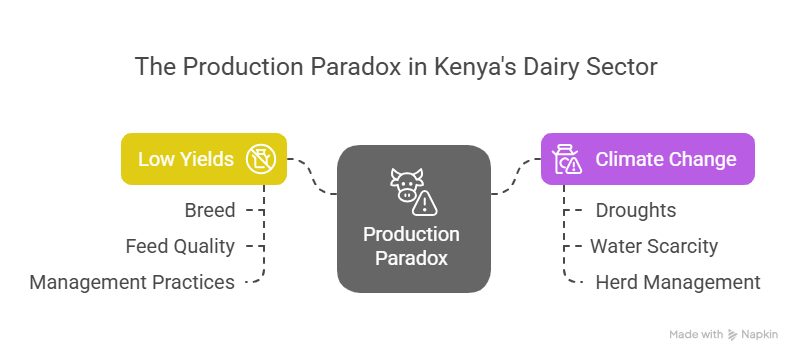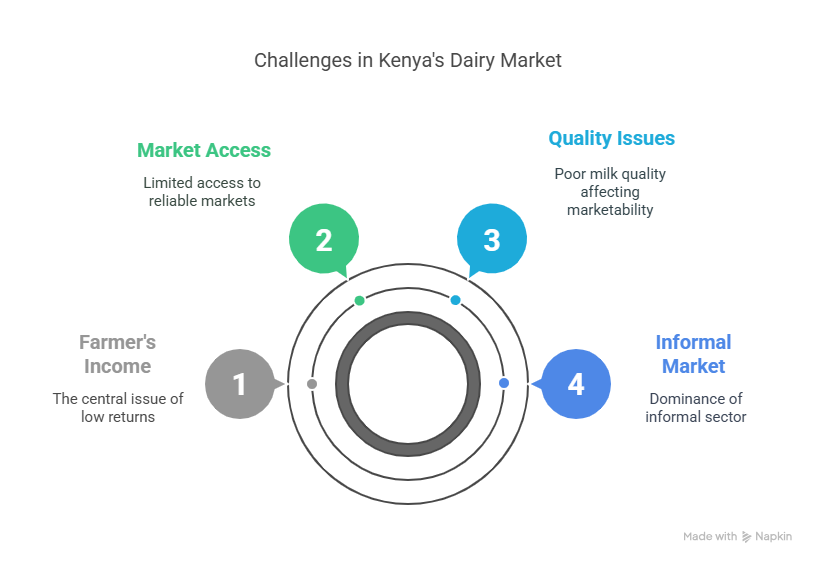Let’s be real – dairy farming in Kenya isn’t for the faint-hearted these days. You’re up against skyrocketing feed costs, unpredictable weather, and a market that sometimes feels like it’s working against you. But you’re still here, still milking, still pushing forward.
This post breaks down what’s really happening in Kenya’s dairy sector – the challenges that keep you up at night and the potential solutions that might just make tomorrow a bit easier. No fluff, just straight talk from someone who gets it.
The Economic Reality Check
If you’re losing money on your dairy operation, you’re not alone. A recent Kenya Dairy Board study delivered some sobering numbers: a model farm with seven dairy cows (four lactating) generated Sh1.33 million in annual sales but racked up Sh1.54 million in costs. That’s a 16% loss – about Sh17,576 going out of your pocket every month.
And if you’re not selling any livestock? Those losses could balloon to Sh520,918 annually. No wonder the KDB warned that “if no action is taken, many farmers will abandon dairy farming.”
The Feed Cost Crusher
Here’s the biggest culprit: feed costs eat up nearly 85% of your operating expenses. Industry reports show feed prices in Kenya running 25-30% higher than Western markets. This forces a brutal choice – limit purchased feeds and rely more on grazing (which caps your production) or watch your profits vanish.
The math just doesn’t add up for many small-scale operations. When your input costs consistently outweigh what you can get for your milk, something’s got to give.
The Production Paradox
Kenya has one of the most impressive dairy sectors in the developing world, hosting 70% of dairy cattle in eastern and southern Africa. Yet we’re caught in a frustrating paradox – lots of cows, not enough milk.
Low Yields, Big Consequences
Production levels swing wildly from 15 to 50 liters per cow daily depending on your breed, feed quality, and management practices. Many farms struggle with extended calving intervals – sometimes by choice to limit feed consumption, other times due to poor herd management.
The result? Kenya produces about 4.6 billion liters of milk annually against a demand of 8 billion liters. That massive supply gap creates market pressure and price volatility that hits your bottom line hard.
Climate Change: The Unpredictable Enemy
Just when you think you’ve got things figured out, here comes another drought. Climate change has turned Kenya’s weather patterns upside down, with increasingly severe droughts hammering the Highland areas of central districts and the Rift Valley – traditionally Kenya’s dairy heartland.
During severe drought periods, milk output can drop by half nationwide. Water scarcity forces tough decisions about herd size and management, sometimes even pushing pastoralists across borders searching for water and feed.
Remember February 2017? When President Kenyatta declared a national disaster due to drought? That wasn’t a one-off – it was a warning of our new normal.

Infrastructure and Tech Gaps
You know the feeling – you’ve produced good milk, but without proper cooling, it’s at risk. Kenya’s dairy sector suffers from insufficient aggregation and cooling infrastructure, leading to quality issues and post-harvest losses that eat into your already thin margins.
The Cold Chain Problem
Without reliable cold chain facilities, especially during high production periods, milk spoilage becomes inevitable. This infrastructure gap doesn’t just hurt your pocket – it undermines the entire sector’s reputation for quality.
Technology Adoption Lag
Let’s talk about breeding, feeding, and herd management. Research shows limited adoption of appropriate technologies across these areas. Artificial insemination programs come and go, quality breeding initiatives appear sporadically, but nothing sticks long enough to transform the national herd.
The result? A technological gap that keeps Kenya’s dairy productivity well below its potential.
Market and Value Chain Headaches
Ever feel like you’re getting squeezed from both ends? You’re not wrong.
The Informal Market Domination
Despite push toward formalization, the informal sector still dominates Kenya’s dairy trade. This creates a fragmented value chain where quality control becomes nearly impossible, price stability remains a dream, and regulatory oversight barely exists.
For you as a farmer, this means uncertain markets and prices that can change on a whim.
The Quality Conundrum
Poor quality milk – whether from inadequate feeding, disease issues, or limited cooling – restricts your market access. Research highlights how these quality issues undermine consumer confidence and kill export opportunities before they can even start.
Market Access Challenges
If you’re farming in remote areas, you know the struggle to access reliable markets. Despite government investments in cold chain infrastructure through New KCC, many regions still lack adequate market linkages.
The fragmented value chain means multiple middlemen each taking their cut, leaving you with lower prices while consumers pay more. This disconnect reduces your incentive to invest in improvements – why spend more on quality when you won’t see the returns?

Knowledge and Support System Failures
You can’t apply what you don’t know. And sometimes in Kenya’s dairy sector, critical knowledge just isn’t reaching farmers.
Broken Extension Services
The International Livestock Research Institute (ILRI) identified “ineffective extension services” as a major factor in Kenya’s milk supply gap. Traditional approaches to knowledge transfer have fallen short, leaving many farmers without access to best practices in feeding strategies, disease management, and quality control.
Weak Cooperative Structures
Dairy cooperatives should be your lifeline – providing collective bargaining power, shared resources, and market access. Unfortunately, many suffer from governance issues, financial mismanagement, and poor service delivery.
Some bright spots exist – cooperatives in Uasin Gishu, Kakamega, and Nyandarua counties have implemented innovative approaches like the dairy farmer assistant (DFA) extension services model. But these success stories remain the exception rather than the rule.
The Policy Puzzle
The regulatory environment for dairy farming in Kenya feels like it’s perpetually under construction – lots of activity but never quite finished.
Slow Policy Progress
The Dairy Development Policy, first formulated in 1993, has undergone multiple revisions (1997, 2000) with a draft Dairy Bill that still hasn’t been enacted. This policy limbo creates uncertainty that discourages investment and hampers coherent industry planning.
Frequent structural changes at ministry level mean implementation often stalls, leading to regulatory conflicts and confusion about which rules apply and when.
Environmental Sustainability Challenges
Your dairy operation doesn’t exist in isolation – it’s part of Kenya’s larger environmental picture, with both impacts and vulnerabilities.
The Emissions Reality
Kenya’s dairy cattle industry generates significant greenhouse gas emissions – about 12.3 million tonnes of CO2-equivalent, with methane making up 96% of that total. This creates a vicious cycle: dairy farming contributes to climate change, which then hits dairy farming with more frequent droughts.
Sustainable Production Opportunities
The good news? Research suggests that integrating sustainable practices along the dairy value chain offers a pathway forward. From drought-tolerant forage grasses like Brachiaria (which could boost milk production by 40% while reducing methane emissions) to treating manure as a valuable by-product, sustainability improvements could simultaneously address productivity and environmental challenges.
Practical Solutions for Kenya’s Dairy Farmers
Enough about problems – let’s talk solutions you can actually implement on your farm today.
Feed Cost Management Strategies
- Grow your own: Maximize on-farm forage production with drought-resistant varieties like Brachiaria
- Silage preparation: Convert excess forage during rainy seasons into silage for dry period feeding
- Feed rationing: Use precise feed formulations based on production levels to avoid wastage
- Group feeding: Separate high and low producers to optimize feed allocation
Productivity Enhancement Tactics
| Strategy | Benefit | Implementation Complexity |
|---|---|---|
| Heat detection and timing | Improved conception rates | Low |
| Regular deworming schedule | Better feed conversion | Low |
| Strategic breeding selection | Gradual genetic improvement | Medium |
| Water access optimization | Increased milk production | Medium |
| Mastitis prevention protocols | Quality milk, reduced losses | Medium |
Water Management During Drought
- Rainwater harvesting: Install gutters and storage tanks to capture rain during wet seasons
- Shade structures: Reduce evaporation and cattle water needs through strategic shade
- Drought-resistant forages: Plant varieties that require less water while maintaining nutrition
- Rotational grazing: Allow pasture recovery and deeper root development
Collective Action Opportunities
Individual changes matter, but some challenges require farmers working together.
Cooperative Strengthening
If your local cooperative is struggling, consider these improvement areas:
- Transparent governance: Push for clear financial reporting and democratic decision-making
- Bulk purchasing: Combine orders for feed and supplies to negotiate better prices
- Shared equipment: Pool resources for expensive but occasionally-used equipment
- Knowledge sharing: Create farmer-to-farmer learning opportunities
Innovative Extension Approaches
The dairy farmer assistant (DFA) model shows promise in regions where it’s been tested. These community-based extension workers provide practical, accessible knowledge transfer that traditional government services often miss. Consider advocating for or organizing similar models in your area.
The Path Forward for Kenya’s Dairy Sector
The challenges facing Kenya’s dairy farming are serious but not insurmountable. The sector contributes about 14% of agricultural GDP and 4.5% of national GDP – it’s too important to fail.
Policy Advocacy Points
As farmers, collective advocacy for these policy reforms could drive meaningful change:
- Feed cost regulation: Push for removal of VAT on feed ingredients and appropriate import controls
- Infrastructure investment: Advocate for expanded milk cooling and processing facilities
- Research funding: Support for local breeding programs and feed formulation research
- Extension services revival: Modernized, farmer-centered knowledge transfer systems
Market Development Priorities
Addressing the informal market dominance requires a balanced approach:
- Quality-based pricing: Advocate for payment systems that reward butterfat content and hygiene
- Consumer education: Build demand for quality-verified dairy products
- Value addition training: Learn simple processing techniques to capture more value on-farm
Resilience in Uncertain Times
Kenya’s dairy sector stands at a critical crossroads. The current trajectory – with unprofitable operations, climate vulnerabilities, and knowledge gaps – isn’t sustainable. But the potential remains enormous.
By addressing feed costs, improving productivity, strengthening market linkages, and advocating for supportive policies, you can help transform Kenya’s dairy industry from crisis to opportunity.
The challenges are real, but so are you – the farmers who get up every morning, milk your cows, and keep pushing forward despite the obstacles. With the right approach, Kenya’s dairy sector can close the supply-demand gap, improve farmer livelihoods, and contribute even more significantly to national food security.
What changes will you implement first on your farm? What collective actions would make the biggest difference in your region? The conversation continues, but now it’s time for action.
Have you tried any of the strategies mentioned in this article? Share your experience in the comments below. Your insights might be exactly what another farmer needs to hear.










